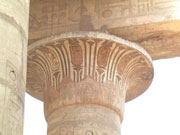TOUR NEWS - SUDAN FEBRUARY 2012
Our 2012 Tour of Sudan ran from the 7th to 23rd of February. We had a keen group for the program which included: Di Thompson, Margaret Debenham, Jenny Cheney, Malcolm Mason and Jan Whallan. The tour was led by me, Michael Birrell, and we were assisted in the Sudan by our local guide Khaled. Since our last visit to the Sudan the previous year, the county had split and we were all interested to know how this affected the locals - our path took us through the north of the country, and everyone we spoke to seemed to agree that the division was better for the country.
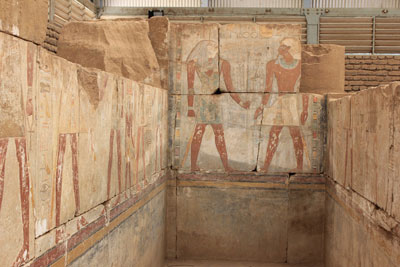 |
 |
The Temple of Buhen in Khartoum Museum |
The 'Black Pharaohs' in the Kerma Museum |
Our flight to Khartoum was on Etihad Airlines - we almost had the flight to ourselves going over. We had our visas processed on arrival and then were met by our local agent who transferred us to the Grand Holiday Villa on the Nile. This is a comfortable Edwardian era hotel with old world charm. We went for a walk along the cornieche (road beside the Nile) and crossed over to Tuti Island where the White and Blue Niles join. This is still mainly rural and we had a look at the locals making mud bricks in the old way.
The following day we went to the Ethnographic Museum - this has a collection of artefacts dealing with the traditional life of the various tribes in Sudan. With the recent partition of the country this collection had an added dimension since many of the objects relate to cultures now in South Sudan. From here we went to the Archaeological Museum - this has a good collection of objects from the various phases of Sudanese culture. A highlight of the collection is undoubtedly the 3 impressive temples (Buhen, Semna, Kumma) which were dismantled at the creation of Lake Nasser in the 1960s and transferred here for their protection. The early Christian frescoes from Faras are also notable. We had lunch down by the Nile and in the afternoon went for a cruise to see the point where the Blue and White Niles join. It is still possible to see where the rivers run side by side - the more fastly flowing murky White Nile on the west and the slower Blue Nile. There was plenty of interest on the shore including some beautiful bird life.
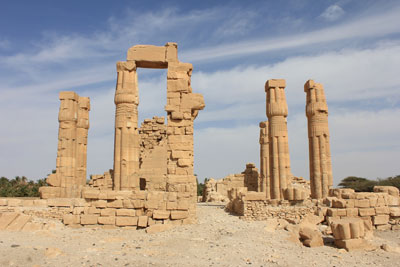 |
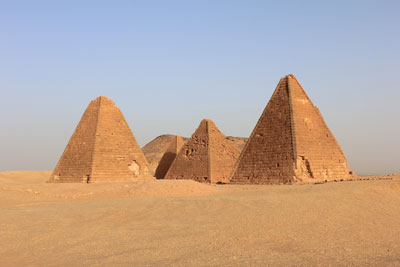 |
The Temple of Soleb |
The Pyramids at Gebel Barkal |
The following day we met our 4-wheel drive crew and headed north out of Khartoum across the open desert, stopping to see some desolate landscapes full of towering ant nests. We had lunch in a local caf� before crossing the Nile and heading to Old Dongola, the capital of the medieval Christian Kingdom of Makauria. This consists of a large area of ruins overlooking a grand view of the river. Nearby are a number of late medieval Islamic domed tombs. That evening we camped in the open desert surrounded by dunes and rocky hills, with brilliant starlight. A sandstorm shook our tents and we saw a wonderful full moon rise over the desert. The next morning the storm had passed and we were up early to see the sunrise.
On our journey north we stopped to visit a traditional Nubian village were we saw the local markets and were invited into one house for tea and to meet the family. We continued northwards, stopping to see one of the enormous crescent shaped barkhan sand dunes which march slowly southwards with the prevailing winds - we climbed to the top of one (about 15m high) and enjoyed the experience of leaping down the steep southward face. We then headed north to Kerma where we saw the site Museum with its impressive collection of royal sculpture, the ruins of the ancient city (dating 2500-1500 BC) and the necropolis. Our second night of camping took place amongst the granite outcroppings near the Third Cataract - a spectacular otherworldly landscape.
On Sunday 12th February we saw the granite quarries at Tombos where Tuthmosis I left a victory stela and also saw an abandoned granite colossus of a Meroitic King. At Sebu we searched out some Neolithic rock art which included a beautiful scene of boats on the Nile. From here we headed to the Third Cataract for a superb view over the desert landscape - the broad sweep of the river is spectacular. North of here we crossed the river on a car ferry and headed across the open desert. A stop at the ancient Egyptian colony of Sesebi enabled us to explore the temple of Amun. Our route north to Soleb followed the old trading route which was marked by the carcasses of dead camels.
We stayed the night in a family compound adjoining the wonderful ruins of the 18th Dynasty temple of Soleb. The temple is richly decorated with scenes which include representations of the sed-festival, an ancient Egyptian rite of renewal. The following day we explored the temple and also went north to see the collapsed temple of Sedeinga. The nearby Meroitic cemetery was fascinating to explore, although we were overrun by midges and had to beat a hasty retreat to the 4-wheel drives - we had to acquire personal mosquito nets to keep them off. In the late afternoon we went for a boat ride on the Nile to see the local crocodiles - some of them were massive and we managed to get quite close before they slid into the river.
The following day we headed south from Soleb, crossed the river, and made for the ancient temple of Kawa. The site was not on the itinerary but we were able to sneak a look at this monument which was constructed by King Taharqa of the 25th Dynasty. We then crossed the open desert until we arrived at the modern town of Karima, our base for the next couple of days.
In Karima we stayed at the very pleasant Nubian Resthouse which consists of ensuite rooms around a beautiful central garden. It was fascinating to watch the local gardeners fertilising the palm trees by climbing up the female plants and sweeping them with male stamens. We walked over to the ruins of the ancient city of Napata and saw the majestic temple of Amun at the base of the Gebel Barkal Mountain. The rock-cut temple of the goddess Mut is very well preserved and shows the goddess standing in front of King Taharqa. After lunch in the Resthouse we visited the site of Kurru where we saw the pyramid tombs of the Kings of the 25th Dynasty and explored two painted burial chambers with scenes from the ancient Egyptian Books of the Netherworld. In the late afternoon we went to see an impressive petrified forest - the well preserved logs, some of them more than 10m long, give a real sense of the ancient landscape.
The following day, Thursday 16th February, was a quieter day. We climbed to the top of the Jebel Barkal Mountain for a magnificent view over the local area - in the far distance we could just make out the pyramids of Nuri. We then went into Karima township - we explored the markets and also went on board one of the abandoned Nile River steamers which line the bank.
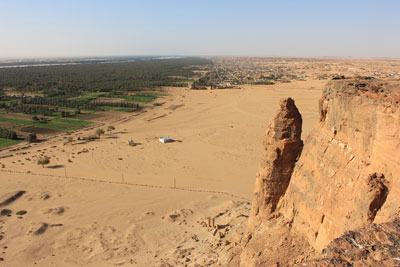 |
 |
The view from Jebel Barkal |
The Pyramids of Nuri |
Our itinerary next took us for a boat ride on the Nile to visit the rocky area downstream from the 4th Cataract. We saw many granite outcroppings, much birdlife, and also saw many goanna-like lizards. We visited a local village and then continued our journey, managed to avoid being shipwrecked (unlike the 2011 tour!). After a well prepared lunch in the palm gardens we went to Nuri to see the impressive pyramids of the Napatan Period (660-320 BC). We climbed to the top of the Pyramid of King Taharqa for a magnificent view of the 19 pyramids in the area.
On Saturday 18th February we left the Nubian Resthouse and after a stop to explore the Meroitic Pyramids of Gebel Barkal we crossed the river and headed to see the ruins of the early Christian monastery at Ghazoli - located in a dry desert landscape it preserves remains of a beautiful church and monks cells. We then headed out across the Bayuda Desert, stopping to see a remarkable landscape of basalt outcroppings. On 2 occasions we encountered the remarkable tribesmen who inhabit the region. They live in wicker huts and tend a few goats as their only resource - I found their simple lifestyle was mindboggling. In the late afternoon we arrived at the permanent tented camp overlooking the ruins of Meroe, capital of a kingdom which flourished from 320 BC to 300 AD. The view of the 40 royal pyramids at sunset is very special.
The following day we visited the pyramid field of Meroe - it was dusty and desolate, and wonderful to be there without any other tourists. The decorated burial chapels are fascinating and contain scenes of the kings and queens in association with Egyptian gods and goddesses. In the afternoon we explored the nearby quarries and saw the ruins of Meroe city, including the Temple of Amun and the �Royal baths�. Our next day was spent looking at the nearby Meroitic ruins. We saw the temples at Musawwaret es-Sufra including the Great Enclosure and the Temple of the Lion God Apademak. After a picnic lunch in a shady side valley, we headed to Naga where we saw the wonderful temple of Amun with its many woolly sheep statues (symbols of the god), and the impressive Temple of Apademak with its relief scenes of the Meroitic King and Queen. On our return to the tented camp there was a spectacular sunset behind the pyramids of Meroe.
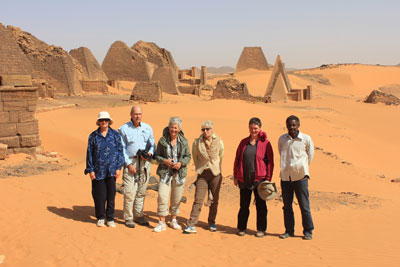 |
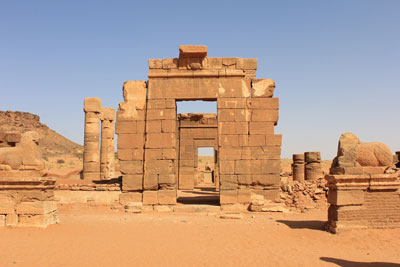 |
Exploring the Pyramids of Meroe |
The Temple of Amun at Naga |
On the 21st February we headed south towards Khartoum, stopping en route for a view over the 6th Cataract of the Nile. Here a granite rock ledge interrupts the flow of the river Nile and we ascended to a wonderful view point with sweeping panoramas of the river valley. We then went to Omdurman where we saw the Museum of Kitchener and the Maadi, all displayed in the house of the Khalifa, the Maadi�s successor. It was fascinating to see objects belonging to Gordon including some of his clothes and water bottle. We went shopping in the little covered markets and then had a pleasant dinner in a Lebanese restaurant - we departed Sudan the following day for our flight back to Australia.
Michael Birrell
